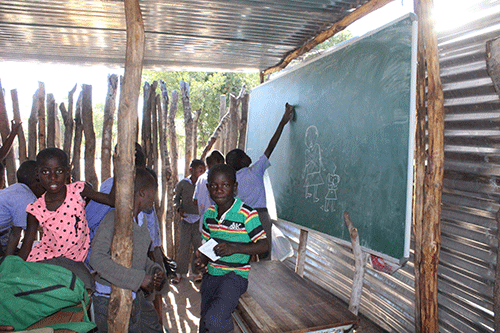Ohangwena is grappling with a shortage of classrooms and furniture at some of its 273 schools across the region.
Director of education Isak Hamatwi informed New Era the region still makes use of 596 corrugated iron sheet classrooms.
He stressed that proper classrooms, adequate furniture, availability of water and electricity supply are all important physical elements that contribute to the delivery of quality education.
The conditions in these classrooms are not conducive for learning and teaching because depending on the weather, learners are exposed to wind, heat, rain and cold conditions.
In some schools that do not have a proper fence or walls, the classrooms are often occupied by goats in the afternoon and evenings, making it unfavourable for the learners.
To compound the situation, the region’s classrooms are overcrowded.
According to Hamatwi, although classrooms are only required to take about 30 learners, primary and combined schools in the region are taking in at least 35 learners.
At secondary level, the number is even stretched further, with classes bulging with up to 45 learners.
“The general norm at our secondary schools is 40 learners per class group. This poses a challenge to secondary school learners,” said Hamatwi.
In addition, the director said the region is facing a shortage of science laboratories at combined schools.
Despite the challenges the region is facing, Hamatwi assured the region is striving to deliver quality education with the little resources it has.
He added that despite the challenge of inadequate classrooms, the region boasts a high percentage of qualified teachers, especially at junior and primary levels.
“This reality mitigates the challenge posed by the lack of proper classrooms in terms of delivering quality education, as the human factor plays a critical role in the provision of education through the enhancement of the quality of the content,” he said.
On a positive note, the director said more than 90% of schools have access to water, which is a critical need during the Covid-19 pandemic.
Equally, all the schools in the region have access to ablution facilities.
He said bigger schools still need additional ablution facilities, as the number of learners overwhelms the available facilities.
The director said the goal of the directorate is to optimise the use of the available limited financial resources and lobby for support from stakeholders.
In the recent months, the region has witnessed support from stakeholders through the construction of classrooms, supply of desks and chairs to various schools within the region.
“The directorate will continue to focus on development and stakeholders' engagement to improve the quality of education we provide,” he said. - nashipala@nepc.com.na


